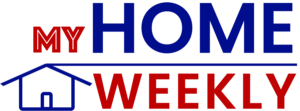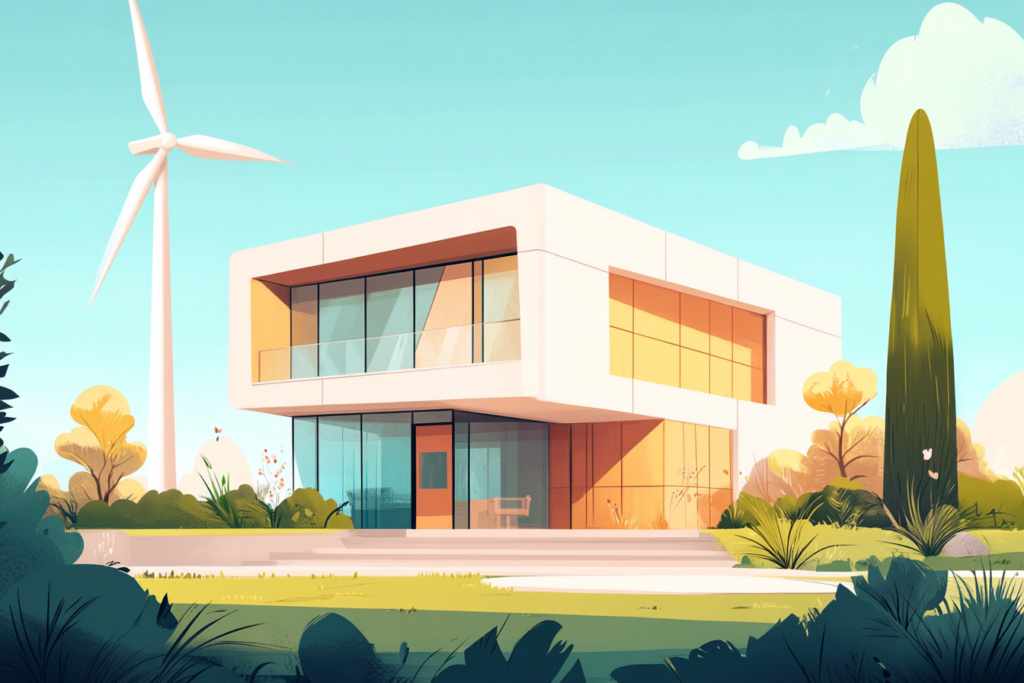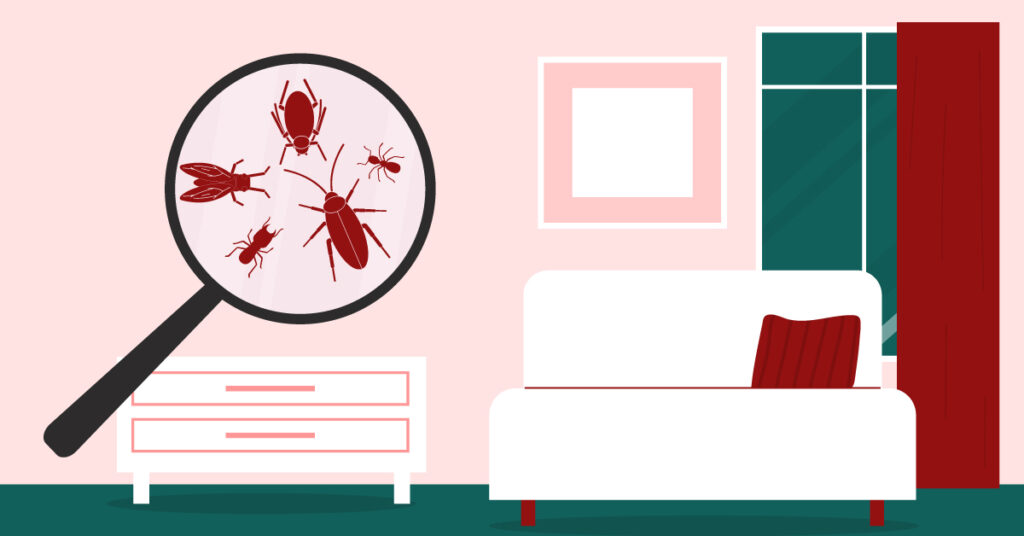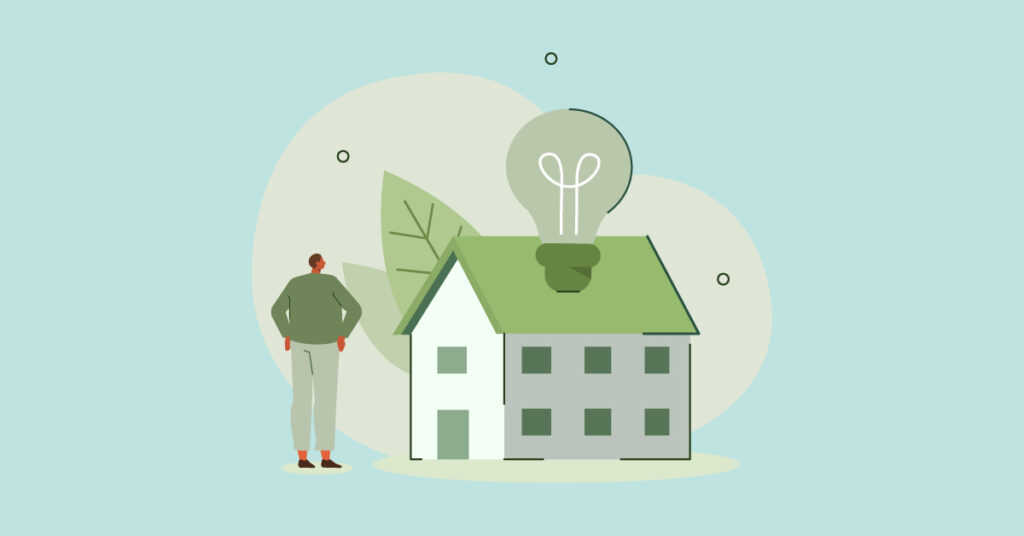With home energy costs continuing to rise and homeowners looking for new ways to be eco-friendly, wind energy has become increasingly popular.
While solar panels are still very popular in residential neighborhoods, small-scale wind turbines represent another viable, though less explored, option for generating home energy. We will share the potential, practicalities, and considerations of harnessing wind power for your home to help you make an informed decision.
Understanding Residential Wind Energy Systems
Residential wind energy systems consist of a turbine, a tower, wiring, and additional components, such as inverters and batteries. Unlike their massive commercial counterparts, which can tower hundreds of feet high with blades spanning over 100 feet, residential wind turbines are scaled-down versions designed for individual property use.
These systems convert wind’s kinetic energy into electrical energy through rotating blades that drive a generator. Most residential systems have capacities from 1 kilowatt (kW) to 10 kW, depending on energy needs, property size, and local wind conditions.
Types of Small-Scale Wind Turbines for Residential Use
When considering a wind turbine for your home, you’ll encounter two primary designs:
Horizontal-Axis Wind Turbines (HAWTs)
These are the traditional “windmill-style” turbines with blades that rotate around a horizontal axis. Benefits include:
- Higher efficiency in consistent wind conditions
- Greater energy output per square foot of swept area
- More established technology with proven reliability
Most residential HAWTs feature three blades and are mounted on towers ranging from 30 to 140 feet tall.
Vertical-Axis Wind Turbines (VAWTs)
With a design where blades rotate around a vertical shaft, these turbines offer distinct advantages:
- Better performance in turbulent, changing wind directions
- Lower starting wind speeds (cut-in speed)
- Quieter operation
- More aesthetically pleasing to some homeowners
- Typically lower height profiles
Popular VAWT designs include Darrieus models (resembling an egg beater) and Savonius types (using curved, cup-like structures).
Assessing Your Property’s Wind Energy Potential

Before investing in a residential wind system, you need to evaluate whether your property has adequate wind resources. Several factors determine if your location is suitable:
Wind Speed Requirements
Most residential turbines require average wind speeds of at least 8-10 mph to generate meaningful electricity. According to the U.S. Department of Energy, the minimum economically viable average annual wind speed is typically around 9 mph (4 meters per second).
Property Size and Zoning Considerations
For optimal performance, a wind turbine needs to be:
- Installed at least 30 feet higher than any obstacle within 300 feet
- Positioned on at least 1 acre of land (though requirements vary by turbine size)
- Compliant with local zoning laws, building codes, and neighborhood restrictions
Many urban and suburban properties face significant challenges meeting these requirements, which is why residential wind systems are more common in rural settings.
Site Assessment Tools
To accurately gauge your location’s potential:
- Consult wind resource maps available through the National Renewable Energy Laboratory
- Consider professional wind site assessments
- Install an anemometer to measure actual wind speeds at your property for at least several months
- Use online wind speed databases that provide historical data for your region
Cost Considerations for Residential Wind Systems
The economics of residential wind power involve several components:
Initial Investment
A complete small residential wind system (1-10 kW) typically costs between $15,000 and $70,000 to install, depending on size, type, and local installation factors. This breaks down to approximately:
- Turbine and components: $10,000-$40,000
- Tower and foundation: $5,000-$20,000
- Installation labor: $5,000-$10,000
- Permits, inspections, and interconnection: $500-$2,000
Smaller rooftop or yard models (under 1 kW) can be found for $500-$5,000 but produce significantly less energy.
Return on Investment
The financial viability of a residential wind system depends on several factors:
- Local electricity rates (higher rates improve payback periods)
- Average wind speeds at your location
- Available incentives and tax credits
- Utility net metering policies
- System lifetime (typically 20-30 years)
Under favorable conditions, a well-sited residential wind system might achieve payback periods of 6-15 years, though this varies significantly by location and system specifications.
Available Incentives
Several financial incentives can improve the economics:
- Federal Investment Tax Credit (reduced to 26% for systems installed in 2023)
- State renewable energy rebates and tax incentives
- Utility company rebates or performance-based incentives
- Property tax exemptions in some states
The Database of State Incentives for Renewables & Efficiency (DSIRE) provides up-to-date information on available programs by location.
Connecting to Your Home and the Grid
Residential wind systems can be configured in three primary ways:
Grid-Tied Systems
The most common configuration connects your wind turbine to the utility grid, allowing:
- Power exchange with the utility grid
- Net metering benefits (selling excess power)
- No need for battery storage
- Continued power supply when wind is insufficient
These systems require special grid-tie inverters and utility interconnection agreements.
Off-Grid Systems
For remote properties without utility connections, off-grid systems include:
- Battery bank for energy storage
- Charge controllers to protect batteries
- Often paired with solar panels for hybrid renewable generation
- Backup generators for periods of low wind
Battery Backup Systems
These grid-connected systems include battery storage to provide power during outages and feature:
- Automatic switching between grid and battery power
- Selective backup for critical circuits during outages
- Higher cost and complexity than simple grid-tied systems
Practical Considerations and Challenges
Before installing a residential wind system, consider these practical aspects:
Permits and Regulations
Navigating the regulatory landscape requires research into:
- Local zoning ordinances (height restrictions, setback requirements)
- Building permits and structural requirements
- Homeowners association restrictions
- Utility interconnection standards
- Environmental impacts and wildlife considerations
Some jurisdictions have specific ordinances governing small wind turbines, while others may require variance applications or special use permits.
Operation and Maintenance
Ongoing care for your wind system typically includes:
- Annual inspections of blades, bolts, and electrical connections
- Periodic bearing replacement (every 5-15 years, depending on design)
- Inverter replacement (typically once during the system lifetime)
- Lightning protection system checks
- Monitoring system performance
Most manufacturers recommend professional inspection every 2-3 years, with costs averaging $100-$500 per visit.
Noise and Aesthetic Concerns
Modern residential turbines are quieter than their predecessors but still produce sound:
- Typical sound levels range from 40-55 decibels (similar to a refrigerator hum) at a distance of 50 feet
- Vertical-axis designs tend to operate more quietly
- Proper siting can minimize noise impact on neighbors
Visual impact remains a primary concern in residential areas, though some homeowners view turbines as attractive symbols of environmental commitment.
Environmental Benefits and Impact
Carbon Footprint Reduction
A 5 kW residential wind turbine in a suitable location can:
- Generate 8,000-12,000 kWh per year
- Offset approximately 5-8 tons of carbon dioxide annually
- Equal the carbon benefit of planting about 1-1.5 acres of forest
The environmental payback period (time to offset the carbon used in manufacturing and installation) is typically 6-18 months.
Wildlife Considerations
While large wind farms have faced scrutiny for bird and bat mortality, small residential turbines pose minimal wildlife risk when properly sited. Studies suggest that household cats, buildings, and vehicles threaten bird populations far more than properly designed small wind turbines.
Innovative Designs and Future Trends
The residential wind energy market continues to evolve with several promising developments:
Hybrid Solar-Wind Systems
These integrated systems leverage the complementary nature of wind and solar resources:
- Wind often peaks when solar production is low (nighttime, cloudy days)
- Shared inverter and electrical components reduce overall system costs
- More consistent year-round energy production
Building-Integrated Wind Turbines
Architectural wind solutions designed specifically for buildings include:
- Turbines integrated into rooflines or building edges
- Wind-capturing building designs that funnel air to turbines
- Smaller, multiple-unit installations that blend with architecture
While still evolving, these technologies offer potential solutions for urban and suburban properties with limited space.
Is a Residential Wind Turbine Right for You?
Wind energy works best for homes with:
- At least one acre of property
- Average wind speeds above 9 mph
- Rural or unobstructed locations
- No prohibitive zoning restrictions
- Reasonable distance from neighbors
- Willingness to maintain a mechanical system
Solar energy may offer a more practical renewable energy solution for many homeowners, especially in urban or suburban settings. However, in the correct location, wind energy can provide substantial, sustainable power with a smaller physical footprint than an equivalent solar array.
Conclusion
Residential wind energy represents a viable renewable energy option for homeowners with suitable properties and wind resources. At the same time, the upfront costs and siting requirements present challenges, small-scale wind turbines offer a path to energy independence, reduced utility bills, and environmental benefits.
As with any significant home improvement, thorough research and consultation with renewable energy experts are essential to determine if wind power aligns with your energy needs, property characteristics, and financial goals. For those in the right situation, harvesting the wind can transform an ancient power source into a modern solution for clean, renewable home energy.
You might also be interested in: Saving Water Throughout Your Home: 25 Tips




